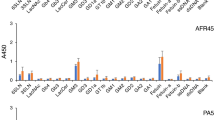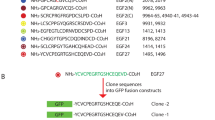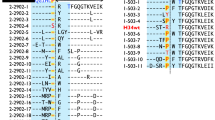Abstract
THE covalent binding of a haptene to its specific antibody with a view to identifying the section of peptide chains which form the combining site has been pioneered by Singer et al.1,2, who named this approach affinity labelling. Antibodies were prepared in rabbits against several aromatic haptenes such as benzene arsonate, and affinity labelling was performed by reaction with p-(arsonic acid)-benzene diazonium fluoroborate through the reactive diazonium group. The reaction with specific antibody was considerably more rapid than that with inert IgG because of the concentration of reagent in the combining site. Subsequent separation of heavy and light chains followed by enzymic digestion led to the isolation of one predominant dipeptide (Val-Tyr) from the light chain and another (Thr-Tyr) from the heavy chain; both of these were substituted on the tyrosine residue. No sequence data were available on the peptide chains of rabbit IgG, but from comparison with the known sequences of the light chains of human and mouse IgG it was suggested that the tyrosine residue 86 in the light chain may have been the one labelled.
This is a preview of subscription content, access via your institution
Access options
Subscribe to this journal
Receive 51 print issues and online access
$199.00 per year
only $3.90 per issue
Buy this article
- Purchase on Springer Link
- Instant access to full article PDF
Prices may be subject to local taxes which are calculated during checkout
Similar content being viewed by others
References
Singer, S. J., and Doolittle, R. F., Science, 153, 13 (1966).
Singer, S. J., Slobin, L. I., Thorpe, N. O., and Fenton, J. W., Cold Spring Harbor Symp. Quant. Biol., 23, 99 (1967).
Koyama, J., Grossberg, A. L., and Pressman, D., Biochemistry, 7, 1935 (1968).
Chaimorich, H., Vaughan, R. J., and Westheimer, F. H., J. Amer. Chem. Soc., 90, 4088 (1968).
Eisen, H. N., Methods in Medical Research, 10, 94 (1964).
Eisen, H. N., Methods in Medical Research, 10, 106 (1964).
Small, P. A., and Lamm, M. E., Biochemistry, 5, 259 (1966).
Givol, D., and Porter, R. R., Biochem. J., 97, 32c (1965).
Fruchter, R. R., Jackson, S. A., Mole, L. E., and Porter, R. R., Biochem. J. (in the press).
Author information
Authors and Affiliations
Rights and permissions
About this article
Cite this article
FLEET, G., PORTER, R. & KNOWLES, J. Affinity Labelling of Antibodies with Aryl Nitrene as Reactive Group. Nature 224, 511–512 (1969). https://doi.org/10.1038/224511a0
Received:
Issue Date:
DOI: https://doi.org/10.1038/224511a0
This article is cited by
-
High-resolution patterning of colloidal quantum dots via non-destructive, light-driven ligand crosslinking
Nature Communications (2020)
-
Photodissociative Cross-Linking of Non-covalent Peptide-Peptide Ion Complexes in the Gas Phase
Journal of the American Society for Mass Spectrometry (2018)
-
Efficient Covalent Bond Formation in Gas-Phase Peptide–Peptide Ion Complexes with the Photoleucine Stapler
Journal of the American Society for Mass Spectrometry (2016)
-
Exploring the flexible chemistry of 4-fluoro-3-nitrophenyl azide for biomolecule immobilization and bioconjugation
Analytical and Bioanalytical Chemistry (2016)
-
Selective chemical protein modification
Nature Communications (2014)
Comments
By submitting a comment you agree to abide by our Terms and Community Guidelines. If you find something abusive or that does not comply with our terms or guidelines please flag it as inappropriate.



